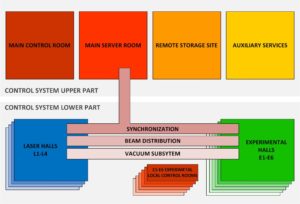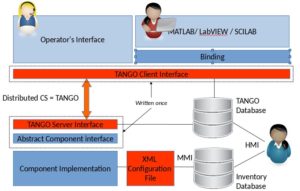Control System & Data acquisition
The Control System (CS) and Data Acquisition System (DAQ) is the technolgy part of ELI Beamlines facility. The main roles of control system can be summarized in two points:
- Operate and control facility technologies
- Provide access for operators and users.
Similarly two points specifying main roles for data acquistion can be written as follows:
- Acquire scientific and requested operational data
- Provide online and offline data processing of acquired data
The facility technologies are distributed in the whole building and its top level view is shown in the following picture.
As depicted in the picture the control and controlled technolgy are divide into two parts:
- Upper part consists of supervisory and supplementary tecnologies where main parts are main control room and server room
- Lower part which in fact describes distribution of controlled technology
There are three main parts of controlled technology:
- Lasers, which are primary sources for physical experiment
- Beam distribution, responsible for beam delivery to experimental areas
- Phisical experiments, the goal of the facility where all the experiments are executed
All of these controlled technologies in ELI Beamlines are working under the same conditions which involves deep vacuum, clean conditions, the technologies also have to be properly synchronized and the beam distribution has to deliver the beam into appropriate experimental area in required quality and properly aligned. All these conditions define technical areas which have to be controlled and supervized:
- Vacuum system, responsible propper conditions of beam distribution
- Beam switch yard, responsible for beam delivery into appriate experimental areas
- Facility level timing system, responsible for technology synchronization
- Beam alignment and diagnostics, responsible for quality of delivered beam
- Experiments control
- Laser control interfaces
As the controlled technology is distributed in the ELI Beamlines bulding, distributed control and data acquisitin systems have to be used. The distributed control system contains two main parts:
- Top level control and data acquisition system responsible for control and data acquisition integration
- Local level control system, which provides direct access to parts of controlled technologies
Of course all parts of control and data acquisition systems have to communicate, therefore one of the key technologies is control system network.
Some of the mentioned technical areas can be considered as a basic like vacuum system, beam switch yard, beam alignment and diagnostics etc. and some of them as a supplementary technologies like timing system, control system network and so on. The supplementary technical areas also contains top level control parts as was mentined above and can be summarized:
- Main control room, is the heart of the control and supervisory system and provides also access for facility operators and users. There are also local control rooms used for local control access and experiments preparations.
- Main server room where are located top level control technologies like control and data acquistion servers
- Remote storage site which provides space for acquired data
- Auxiliary services,like building management system interface, personal protection interface and others.
- Data storage
- Control system network
Control System & Data Acquisition hardware technologies
Top level Control system technologies are based on standard server and ethernet network components.
Top level data acquisition system is based on HPC technologies like blade servers and specialized low latency network technologies, for example Infiniband and RDMA with combination of ethernet components with support of RDMA. Low latency networks used in HPC world gives us also the opportunity to connect top level data acquisition system directly with HPC for offline data processing, which is beneficial for users. One of the key technologies are FPGA card which can provide online data processing of acquired data. The integral part of top level data acquisition system is also data storage. Multitier data storage technology is used and is organized into tiers:
- Tier 0 is a special part in ELI Beamlines and is implemented by data acquisition server memory, this tier is responsible for storing of first bunch of data, these data can be later strored in followin standard storage tiers
- Tier 1 are SSD drives
- Tier 2 are conventinal and cheapper rotational hard drives
- Tier 3 is a tape library used as a long term data storage and backup
Local control system technology is divided into two types:
- Industrial control, for example vacuum control or motion control, in this case standard and economic automation technologies (PLC, standard IO) are used
- Advanced control, for example experiment control, here ELI Beamlines has adopted Micro TCA architecture
Local data acquisition system also uses two technologies
- Micro TCA as used also for advanced local control system
- PCI Expres based computers, which are de facto wideli used standard computers and gives the opprtunity to use PCI Express based cards available in the ‚standard‘ market and available for most of the users
Control System & Data Acquisition software
The control system software is based on TANGO Controls framework which is available as a free software. The TANGO is based on RPC technology and provides unified access to all software components of distributed control system. One of the advantage of the TANGO Controls framework is its object oriented architecture. As the the TANGO Control system is used by many facilities in the world there exists interfaces to existing devices and bridges to user software frameworks used by scietists like GNU Octave or Matlab.
Specific software is also developed in ELI Beamlines to satisfy internal and user requirements. The approach to software development in ELI Beamlines may be summarized in few points:
- Object oriented, Mode and Componentl based development
- Use abstract API for sofwtare components
- Use generic programming
- Use configurable software components (XML)
- Use plugins with defined abstract API
- Use automatic software generation
- SCPI protocol is an example
The component based approach is shown on the following picture.
Also special software components were developed or are in development in ELI Beamlines, examples are:
- TANGO LabVIEW bridge
- Graphical User Interface (GUI) with support for online generated software and 3D technology model
- SCPI automatic software generator for instrumentation with TANGO support
- Fieldbus interface for TANGO
User access & User Interfaces
User access would be as simple as possible, shall support standard software tools used by user/scientific community and provide user technology integration environment. In summary, all these requirements are fulfilled by:
- Cloud technologies on the top level which provide well controlled and consistent user access and system virtualization
- Software interface technologies base on abstract API
- Matlab is naturaly supported by TANGO framework
- LabVIEW access is supported by LabVIEW/TANGO interface suite developed in ELI Beamlines
- All local Control and DAQ components are available through known abstract TANGO API for any supported language (eg. Python)
- Control system and DAQ testbed and control system laboratories are available for user technologies integration







